Winter 2016: Energy Evolution
From carbon dioxide conversion to landfill mining, researchers at UTA are seeking viable alternative energy options.
Skip to content. Skip to main navigation.
From carbon dioxide conversion to landfill mining, researchers at UTA are seeking viable alternative energy options.
Found in everything from space shuttles to dental fillings, composite materials have thoroughly infiltrated modern society. But their potential is still greatly untapped, offering researchers ample opportunity for discovery.
Within the particle showers created at the Large Hadron Collider, answers to some of the universe’s mysteries are waiting.
Model systems like pigeons can help illuminate our own evolutionary and genomic history.
UT Arlington's tiny windmills are bringing renewable energy to a whole new scale.
The stability of our highways, pipelines, and even manholes is reaching a breaking point.
Scientists believe they have discovered a subatomic particle that is crucial to understanding the universe.
UT Arlington researchers unlock clues to the human body’s most mysterious and complex organ.
UT Arlington researchers probe the hidden world of microbes in search of renewable energy sources.
Wounded soldiers are benefiting from Robert Gatchel’s program that combines physical rehabilitation with treatment for post-traumatic stress disorder.
Tiny sensors implanted in the body show promise in combating acid reflux disease, pain and other health problems.
Nanotechnology researchers pursue hybrid silicon chips with life-saving potential.
Biomedical engineers combat diseases with procedures that are painless to patients.
Photograph By Gallery Stock
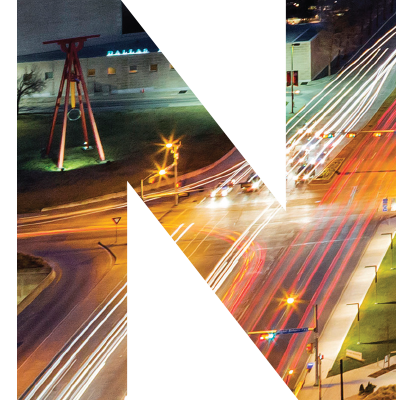 ot so long ago, cotton fields and pastures blanketed much of the North Texas landscape. Today, those once-rural lands are host to bustling suburbs that draw thousands of new residents and businesses each year and are connected by a maze of highways to the urban centers of Dallas, Fort Worth, and Arlington.
ot so long ago, cotton fields and pastures blanketed much of the North Texas landscape. Today, those once-rural lands are host to bustling suburbs that draw thousands of new residents and businesses each year and are connected by a maze of highways to the urban centers of Dallas, Fort Worth, and Arlington.
By all accounts, the North Texas population is booming. With more than 7 million people, the region is the nation’s fourth most populous metro area and the second-fastest growing in the country. And the influx of new residents shows no signs of slowing.
But with explosive growth comes challenges, from choked roads and highways to a dearth of affordable housing. As cities and counties plan for expected growth, they are grappling with one of the biggest challenges yet: How can livable, sustainable communities be developed in a region defined by urban sprawl?
Definitions of livable communities vary. The American Society of Landscape Architects says such communities offer “rich social, economic, and environmental benefits.” For the AARP, a livable community “is one that is safe and secure, has affordable and appropriate housing and transportation options, and offers supportive community features and services.”
The University of Texas at Arlington has emerged as a leader in this growing field and an invaluable research engine for urban planning. UTA professors help cities and communities study housing and transportation, identify challenges, and plan for the future of North Texas and beyond.
Tucked into an office on the fourth floor of the College of Architecture, Planning, and Public Affairs (CAPPA), Shima Hamidi leads the Institute of Urban Studies, one of the jewels of the college.
Since Dr. Hamidi arrived in 2015, the institute’s funding has jumped from $60,000 to more than $700,000.
Then, in January of this year it was awarded a five-year grant from the U.S. Department of Transportation for transportation research, education, and outreach that is expected to be worth up to $7.7 million.
Established in 1967, the institute provides customized planning and management services for Texas cities and public agencies while giving students real-world experience.
“There is enormous potential for this institute given the unprecedented growth this region is facing,” says Hamidi, CAPPA assistant professor. “Our research laboratory is essentially in our backyard.”
Recent projects for the institute have included a study to reinvigorate Fair Park in Dallas, a walkability assessment of downtown Dallas, a survey of food deserts in Fort Worth, and a study to explore how a northern entrance/exit to Dallas Love Field airport would affect the surrounding community.
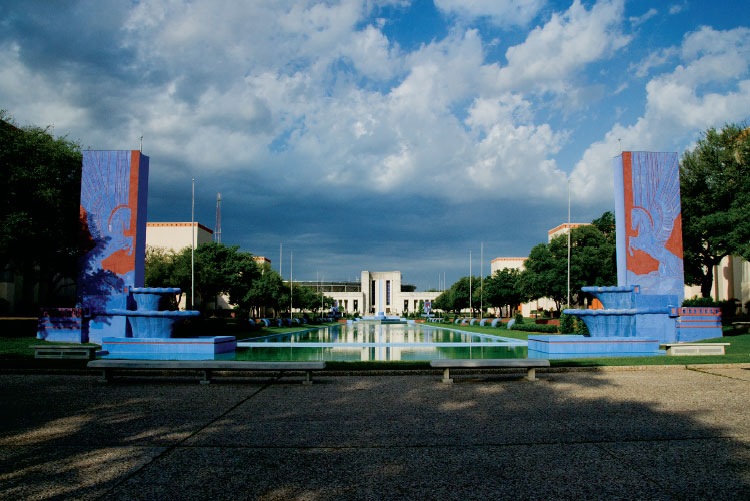
The Institute of Urban Studies created an innovative plan to revitalize Fair Park in Dallas
Take Fair Park, for example. Originally built in 1886, the park is home to the State Fair of Texas, but city and community leaders have begun in recent years to look for ways to revitalize the lagging area, draw visitors outside the annual fair, and address the maintenance and renovation of historic structures.
Five graduate students—Iman Amini, Priscylla Bento, Gwen Ikokpan, Reza Paziresh, and Ahoura Zandiatashbar—studied the park and surrounding neighborhoods as part of a grant from the Dallas-based Foundation for Community Empowerment, which works on issues affecting South Dallas.
In Fair Park: The Reinvigoration of a National Treasure, the student researchers suggested the park be reconfigured to connect major corridors with adjacent neighborhoods, creating a vibrant signature urban space.
To accomplish this, they suggested removing the existing fence surrounding Fair Park, connecting the historic cultural district with Dallas Area Rapid Transit and a trolley line, adding walking and bicycling paths, and converting some surface parking lots to park land. The plan would leverage increased visitor dollars to offset costs.
The team employed a comparative analysis of successful urban parks, including Klyde Warren Park in downtown Dallas, Millennium Park in Chicago, and Central Park in New York City. They compared current State Fair circulation patterns to amusement parks—such as Six Flags Over Texas and Disney World in Orlando—that use loop circulation patterns to expose visitors to more of the parks’ attractions.
To gather ideas, students conducted focus groups and town hall meetings and also met with park tenants and neighbors.
“Fair Park has great potential,” Hamidi says. “By bringing in so many stakeholders, we can ensure they have a strong voice in the project.”
In her office, Hamidi points to a map of the United States covered in red and orange splotches. “Which parts of the country offer the most affordable housing?” she asks.
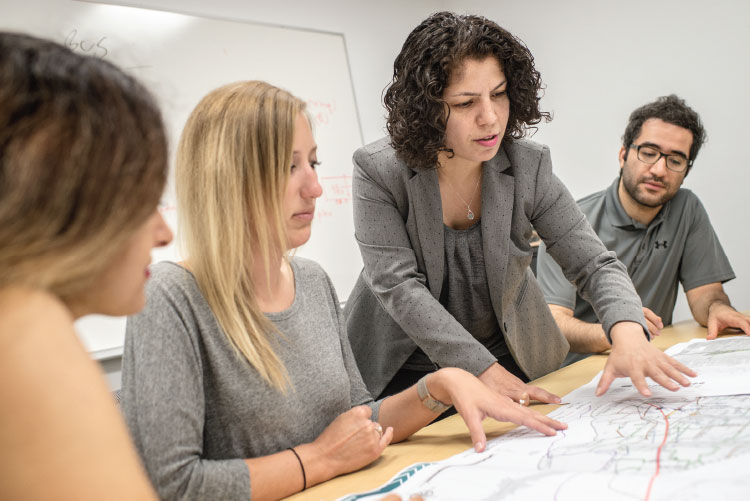
Shima Hamidi works with graduate students to provide cities with customized planning and management services
To answer the question, she collaborated with University of Utah Professor Reid Ewing to study low-income housing across 15 metropolitan areas, including North Texas.
Using household data and information on 8,857 U.S. Department of Housing and Urban Development (HUD) properties, Hamidi discovered that affordable housing is frequently not so affordable when transportation costs are considered.
“Are we providing real affordability?” she asks. “Unfortunately, the answer is no.”
As defined by HUD, affordable housing should cost less than 30 percent of a household’s income. But when transportation costs such as gas prices, insurance, and vehicle maintenance are added to the bill, those percentages soar.
At the time of the study, 44 percent of affordable housing units nationally had occupants who spent, on average, more than 15 percent of their income on transportation costs. But in areas without public transit, this ratio of transportation costs to incomes rose dramatically: Dallas clocked in at 72 percent, Phoenix at 97, and Buffalo at 84, for example.
“When a household is paying so much for housing and transportation, there is nothing left for health care, education, or food—the basic needs of a family,” Hamidi says. “Transportation can be a hidden and devastating cost.”
Yet in some cities known for soaring housing costs, residents of low-income affordable units paid little in transportation costs. In San Francisco, no households spent more than 15 percent of their income on transportation. In Los Angeles, the number hovered at 3 percent, and Chicago at 9 percent.
“This is a huge issue,” Hamidi says, “but it has a relatively easy solution.” In her article in Housing Policy Debate journal, she and Dr. Ewing wrote that HUD should provide affordable housing with “more compact, walkable, and transit-served” neighborhoods rather than “auto-dependent” areas. In places where that is not possible, subsidies should be higher to account for higher transportation costs.
“Location matters,” she says. “This is a social equity issue. Are we creating an environment that gives everyone an opportunity for upward mobility?”
Public health and transportation are inextricably linked. A particular placement of a sidewalk can encourage walking, for instance, just as an urban trail can spur bicycling to work.
Yet for decades, government agencies around the country have ignored health factors, relying only on traffic patterns, cost, and safety when developing long-range transportation plans.
No longer. Civil engineering Associate Professor Stephen Mattingly, along with former CAPPA Associate Professor Colleen Casey, have created a comprehensive set of guidelines for the North Central Texas Council of Governments, or NCTCOG, that takes into account public health measures in a transportation plan.

Researchers created a set of guidelines for the NCTCOG that considered factors like walkability and pedestrian safety
The work is closely related to the Transportation Research Center for Livable Communities, a federally funded consortium of five universities, including Western Michigan University, its home base. As a member of the center, Dr. Mattingly has studied a variety of transportation issues, including the effect of blame-the-victim narratives on local policies to improve pedestrian and bicycle safety and the use of technology like cellphone apps and crowdsourcing to improve street safety.
“Livable communities are essentially about quality of life,” says Dr. Casey. “And we know that transportation plays a critical role in quality of life and livability. The ability to move from point A to point B is directly related to issues of housing, health, and economic mobility.”
To create the guidelines, Mattingly and Casey compiled an inventory of public health performance measures related to three areas: safety, physical activity, and air quality. Next, they developed a databank of transportation infrastructure elements that affect public health, such as sidewalks, protected and unprotected bicycle lanes, and crosswalks. Working with student researchers, the professors designed four indexes: pedestrian safety, bicyclist safety, walkability assessment, and a bikeability assessment.
The project also includes a summary of successful public health transportation measures adopted by metropolitan planning organizations around the country.
“When we look at a community, connectedness ranks very high on the list of whether people are happy where they live,” Mattingly says. “Public health, mental health, and physical health all benefit from smart land use.”
His team evaluated numerous factors, such as the number of driveways per block, width of sidewalks, speed limits, and presence of crossing guards. They compiled the information in a guidebook that government agencies or community groups can use to rate transportation infrastructure in a given location.
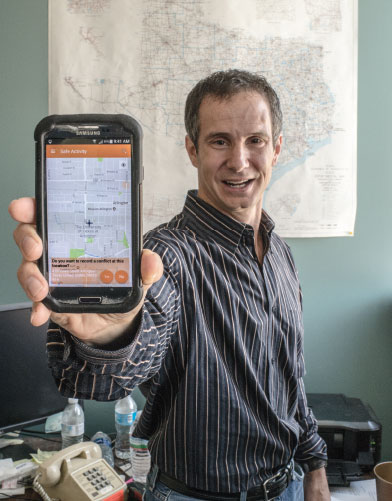
Stephen Mattingly created an app that uses crowdsourcing to assess bicycle/ pedestrian conflicts
“Decision-makers must be able to weigh the consequences of investing in different options, which can be a challenging task because priorities sometimes conflict,” Casey says. “For example, is it better to invest in widening a sidewalk, installing a midblock crossing, or are both necessary to realize improvements in public health?”
NCTCOG, whose members include some 230 counties, cities, and school districts spanning North Texas, can use the tools to develop the Metropolitan Transportation Plan, a blueprint for transportation systems and services aimed at meeting mobility needs for the next 25 years.
Although developed for NCTCOG, the guidebook may also help programs such as Safe Routes for Schools, a network of local, state, and federal groups that work to improve the health and well-being of children by encouraging them to walk and bicycle to school.
“All children should be able to get to and from school safely, and ideally that should be by walking or bicycling,” Mattingly says. “Even with limited resources and money, small changes like crosswalks can have a big impact on livability.”
One in three Americans is now 50 or older. By 2030, one in five will be 65 or older.
As they age, an overwhelming majority of older adults—87 percent of those over 65—say they want to remain in their current home and community, according to a recent study by the AARP. To do so will require access to transportation, grocery stores, and doctor’s offices, among other services.
So how well is Arlington meeting these needs for its aging residents?
UTA social work Professors Gail Adorno and Noelle Fields conducted an assessment of Arlington with United Way of Tarrant County and the Area Agency on Aging of Tarrant County to determine just that. The project was part of a study by the Texas Department of Aging and Disability Services.
Drs. Adorno and Fields worked with Meals on Wheels and local community groups to identify 60 volunteers, ranging in age from 55 to 92 years old. Of those, 15 were homebound or unable to drive. Over the span of a few months, researchers interviewed the participants in their homes and in focus groups.
“What does aging well mean to these folks?” Adorno asks. “Our results were not surprising, but they were very revealing.”
Older adults across all income and racial demographics reported a lack of transportation mobility as an enormous barrier to aging well. Most of the adults they interviewed had deep roots in the Arlington community, and many now worried about their ability to live here independently.
Although some participants reported isolated neighborhood improvements, most listed numerous obstacles to mobility, including inadequate public transportation, absent and uneven sidewalks, limited walking paths and pedestrian amenities like benches, and an overall culture that does not promote pedestrian safety.
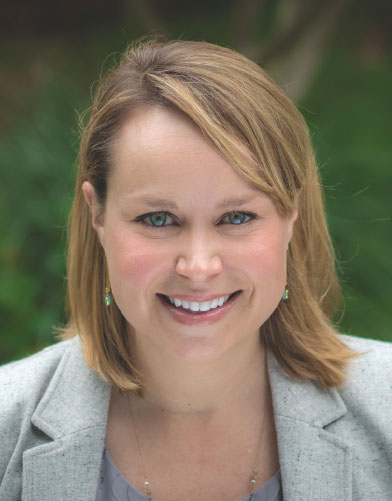
Social work Professor Noelle Fields is helping Arlington better serve senior citizens who are living independently
“The primary theme became transportation,” Adorno says. “Over and over, people told us they felt socially isolated, removed from their own community. They no longer felt valued.”
The duo presented its findings to various Arlington city and community groups and recommended the city repair infrastructure to improve pedestrian safety and implement affordable, accessible transportation.
“What is good for the aging population is also good for young families and workers,” Fields says. “The ability to live well and age well in our community affects us all.”
Now, the professors are working with civil engineers and computer scientists to develop a transportation-based web application. UTA will provide tablets to the research participants, who will record a daily transportation log.
How did they get to the doctor or their place of worship, for instance? Where did they walk today? Were they forced to miss a job interview because of transportation?
The data will help the researchers pinpoint strengths and weaknesses of local transportation and develop more tailored recommendations to planners. The project is funded by the Transportation Research Center for Livable Communities and NCTCOG.
“This is a new way of both looking at transportation and collecting data,” Fields explains. “If we can tap into the intergenerational support for livable communities, we can make a lot of strides.”
As a sign of its growing expertise in sustainable communities, the University recently won three U.S. Department of Transportation (DOT) grants to continue its efforts to reshape North Texas. The grants could total $12 million in funding for the next five years.
The first, worth up to $7.7 million over a five-year period, will establish a Center for Transportation Equity, Decisions, and Dollars (C‑TEDD) on campus. Led by Hamidi, the new center will assist transportation leaders and elected officials in making wiser, more informed decisions about transportation through the information and data it provides. C‑TEDD will focus on preserving the existing transportation system while aligning decision-making and funding sources to achieve efficiency, equity, and upward social mobility.
For the second U.S. DOT grant, UTA researchers will collaborate on a Louisiana State University-led UTC to improve transportation infrastructure through research into innovative materials and new technology. The third DOT grant is led by Portland State University and centers on developing institutional infrastructure, evaluating transit connections, and developing a non-motorized data archive and tools.
“The announcement of these awards signals a transformational achievement by CAPPA, civil engineering, and UTA as we focus on enabling the sustainable megacity that the Dallas/Fort Worth region will become in the next decade,” says University President Vistasp Karbhari. “It ensures that our faculty, researchers, and students will be at the very center of progress and advancement, and will contribute significantly to quality of life in the years to come for North Texas and for the country.”